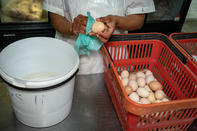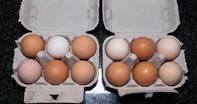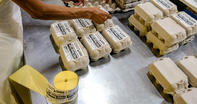
Correct Sizing

Eggs of different sizes may not be packed together in the same container and they should be displayed separately when sold loose. The following weights are used:
- A Super Jumbo egg should weigh more than 72 g
- A Jumbo egg more than 66 g
- An Extra Large egg more than 59 g
- A Large egg more than 51 g
- A Medium egg more than 43 g
- A Small egg more than 33 g
- Mixed sizes should weigh more than 33 g and should be clearly marked as mixed sizes even when sold separately to prevent confusion
Correct Grading
Eggs with different grades may not be packed together in the same container and they should be displayed separately when sold loose. Eggs that do not complying with grade 1, 2, or 3 may not be sold in South Africa.Grade 1/Grade A
The egg white should be thick and the egg should have a round, well centred yolk. The air cell should be small, to a maximum depth of 6 mm, and moves less than 6 mm in any direction when the egg is tilted in a vertical direction.
The egg should be free from meat spots and the shell should be clean, not cracked and strong. The eggs whites should have a huagh value of at least 55 units.
(This measurement looks at the protein quality of an egg, based on the height of its egg white. Fresh and higher quality eggs have thicker whites than poorer quality eggs.)
Grade 2/Grade B
Very few of these eggs are sold at retail stores. The yolk is slightly flattened and the white thinner than the whites of eggs qualifying for Grade 1. The air cell has a maximum depth of 9 mm and moves less than 12 mm in any direction when the egg is tilted.
The shell is not cracked, may have a rough texture and may be slightly soiled or stained. The egg whites should have a haugh value of at least 35 units.
Grade 3/Grade C
These are not sold in retail stores. The yolk is flattened and may be oblong in shape, while the white is thin and watery. The shell may be cracked and or stained.Packaging and Marking

Egg packaging should not give off any taste or odour. It should be strong, unbroken and close properly to protect the eggs during normal handling and transportation.
It should not absorb excessive moisture during cooling and it should be cleaned properly and previous labels should be removed, if the container is being recycled for use. Suitable packaging includes simple baskets for short distance transportation and egg collection, filler trays and polystyrene packages.
Free-range eggs, barn eggs and pasteurised eggs need to comply with stipulated regulations to be labelled as such. The following information should be on the label:
- The name of the product
- The name of the company (trade name)
- Details of the packer
- The best before date
- The number of eggs
- Trade Metrology
- Size
- Country of Origin